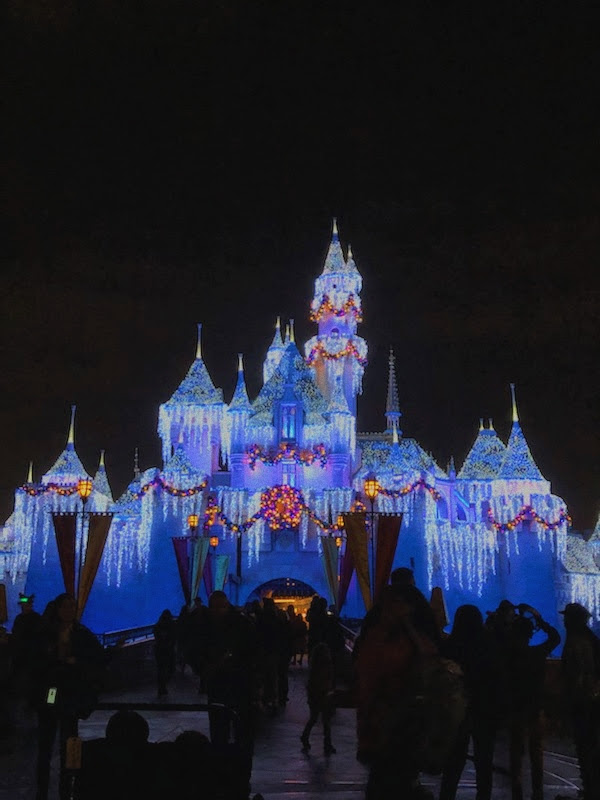When Disney gets dark
Can Disney be excused from their mistakes or is their impact on culture irreversible?
The Disneyland castle dressed up for Christmastime showing the magical appeal of Disney.
October 6, 2021
Many of us grew up with Disney films and have fond memories that each movie created, like “Snow White” with the seven dwarves. Each feature is magical and well-written, with beautiful animation, memorable characters, iconic soundtracks, and a little pixie dust. It’s important to recognize Disney’s effect on children.
A positive aspect of Disney movies is that they promote altruism to kids. A study by family life researcher Sarah Coyne found Disney films contain one act of kindness every minute on average, such as sharing, helping, or offering kind words. In comparison, this is seven times the level of such behaviors found in other children’s television in America.
Unfortunately, the revered “happily ever after” theme present in Disney films is often surrounded by unrealistic expectations and negative messages that can’t be dismissed with the excuse of being classics.
Take films such as “Beauty and the Beast,” for example: the character Belle develops Stockholm Syndrome and a love for her captor. Many Disney princess movies teach viewers that they must sacrifice themselves to find true love. We must recognize that popular media often perpetuates unhealthy and abusive ideals in romance. But this isn’t the only issue that the films promote.
There are many examples of cultural insensitivity in earlier Disney films, which, despite disclaimers, remain profitable for Disney, such as the song “What Made the Red Man Red” in “Peter Pan,” presenting Indigenous people as comically stereotypical Native Americans with exaggerated behavior and features. Another example is “Song of the Roustabouts” in “Dumbo” which depicts faceless men of color hammering railroad ties to put up circus tents. They sing lines such as, “we slave until we’re almost dead. We’re happy-hearted roustabouts”, seeming like they are happy to do strenuous work for little pay.
Even though these films are old, the blatant racism in the songs and stereotyping of certain characters should never have been acceptable. Disney also has a way of twisting serious, real life events into love stories or seeming utopias to fit the Disney ideal, like how Pocahontas and John Smith were real people that Disney manipulated to create an inaccurate romance.
It’s important to acknowledge that the company has put disclaimers on the movies with racism, inaccuracy of historical events, even making certain movies unavailable on Disney+ for viewers under 7. But the question remains: do we learn from Disney by recognizing failures, or by fixing their mistakes?
Since the release of “Snow White” in 1937, Disney has promoted other harmful stereotypes. In another study by Coyne, 198 preschoolers and their parents were examined to observe if watching Disney princess movies adhered to gender stereotypes. After two years of research, 90% of boys never picked up a princess doll while 60% of girls played with their doll at least once a week. According to their parents, 89% of boys acted out their gender stereotype (playing roughly, etc) and 79% of girls acted out theirs (playing quietly, etc). What children are watching can significantly influence how they identify themselves, enforcing the Disney idea of gender roles in society.
Along with this, Disney princesses have an unattainable body image, as these princesses set extreme body standards for young children from the start with their toothpick-thin waists and disproportionate features. A majority of the early films have a lack of diversity, only centering the narrative on thin, white protagonists. By doing this, Disney subtly teaches young viewers that they need to be white and attractive to be recognized as having value, and to fit the Disney ideal of beauty.
Disney princesses may be positive role models for children, but that doesn’t make up for the amount of damage their image has on society’s standards today.
The Walt Disney company is obviously different from how it was in the past. Throughout the years, Disney has become more progressive in their filmmaking, though it has taken a while. The company acknowledged their mistakes in older movies, and newer films are more inclusive, with more diverse characters, backgrounds, and cultures. However, some think that these changes aren’t enough to reverse their impact on Western society and the lack of appreciation and understanding of other cultures.
The takeaway is that we shouldn’t expect companies in the film industry to be perfect. We must be aware of negative messages and stereotypes in each movie, and strive to do better in the future.



